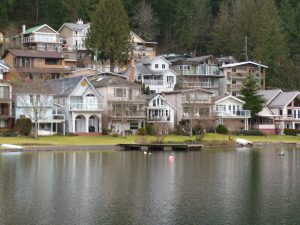 DISTURBING TREND ALONG LAKE SHORES
DISTURBING TREND ALONG LAKE SHORES
There is a disturbing trend underway along the shores of many BC lakes and its called urbanization. It wasn’t too long ago that people were content with low impact, small scale development: a small cottage and float with minimal clearing. If you had to access the property by boat, so much the better. Many people of today seem to require more. Much more. It seems that today’s shore dwellers have forgotten how to live in the country because they insist on dragging their city comforts along with them. Power, pavement and houses and lawns that would not look out of place in the Hollywood Hills.
The thought is, if the shore is swampy or brushy or if trees mar the view, bring in machines to create a beach and remove the offending vegetation so trucks can be driven to the water’s edge to haul away any driftwood that dares to land on the property.
If erosion occurs because the shore zones natural defenses have been stripped, bring back the machines to build retaining walls or line the shore with shot rock.
It’s a depressing scene that seems to occur almost everywhere people choose to live by lakes. The Cowichan Lake Salmonid Enhancement Society, a stewardship group in Lake Cowichan recently found that nearly 70% of lake shore properties on Cowichan Lake had moderate to high impacts on the shores. In travelling around the province, I would say as much or more degradation has happened on numerous lakes like Christina, Okanagan, Shuswap, Kootenay Lake’s West Arm – the list goes on.
Shore zones are the most productive parts of our lakes, especially the larger lakes like those I have cited here. The same things that help provide production on natural shores, also attract human activity. Things like protection from wave attack and gentle slopes. These are among the first areas to go.
Is it possible to live on a lake shore without degrading its natural values too much?
I think it is but it requires a dedicated commitment to living light. First off there are parts of lakes that should simply never be developed. They need to remain as nature reserves, parks or rec sites. The portions of lakes that can be in the real estate market place should be subject to constraints like a protected setback from the high water level. Natural vegetation would be retained and a small dock for swimming or sunning would take the place of a beach or lawn. Access would be in the form of narrow gravelled paths.
Perhaps the most attractive feature of BC is its number and variety of lakes. Because of our glacial history and ample water, we have an abundance of beautiful, clean lakes that support excellent fish populations. These lakes are the envy of the world and a priceless gift that must be carefully stewarded . Indeed.